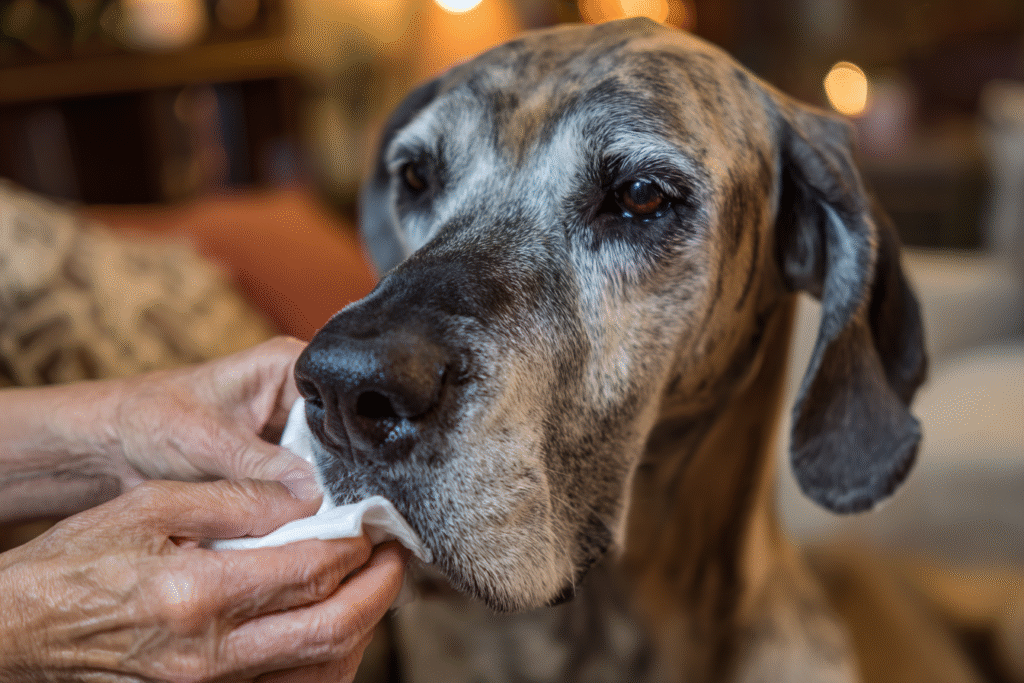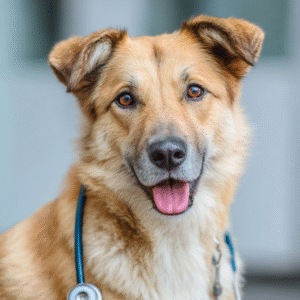Understanding and Treating Bumps on Dogs Chin
Discovering bumps on dogs chin can be an alarming experience for any pet owner.
These unwelcome blemishes, often a form of dog acne on chin, can range from minor irritations to more serious infections.
Furthermore, when you notice bumps on a dogs chin, it could also be a case of dog pimples on chin or even puppy acne in younger dogs.
Understanding the root causes and available treatments is the first step toward helping your furry companion find relief.
Table of Contents
- What Do These Bumps on a Dog’s Chin Look Like?
- Exploring the Causes of Dog Acne on Chin
- Why a Veterinary Diagnosis for Dog Pimples on Chin is Essential
- Effective Treatment Plans for Your Dog’s Chin Bumps
- Vitaplus (Vidatox): A Natural Approach to Inflammation and Pain
- Managing and Preventing Future Flare-Ups of Puppy Acne
- Frequently Asked Questions
What Do These Bumps on a Dog’s Chin Look Like?
When you first notice bumps on dogs chin, they typically appear on the lower jaw, chin, and around the lips.
Initially, you might see small, red bumps, very similar to human pimples.
As the condition progresses, these bumps on a dogs chin can develop further. You may observe swelling of the muzzle, some hair loss in the affected area, and lesions that become filled with pus.
In more advanced cases, these bumps can rupture, ooze fluid, and eventually form crusts or scabs, causing significant discomfort for your pet. Identifying these signs early is crucial for effective treatment.

Exploring the Causes of Dog Acne on Chin
The underlying reason for dog acne on chin is often an inflammation of the hair follicle, a condition known as folliculitis.
This frequently happens when a dog’s short, coarse hairs break off and are pushed back under the skin’s surface, triggering an inflammatory response.
This inflammation can lead to a deeper infection called furunculosis, where the entire follicle becomes painfully infected. Consequently, this is a primary reason you might see bumps on dogs chin.
Several factors can contribute to this initial trauma:
- Genetics and Breed: Short-coated breeds like Boxers, Bulldogs, Great Danes, and Rottweilers are genetically more susceptible to developing dog acne on chin.
- Age: The condition is quite common in younger dogs, which is why it’s often referred to as puppy acne. Most cases appear when a dog is between six months and one year old.
- Trauma: Rough play with toys or other dogs, or even persistently rubbing their chin on carpets and furniture, can damage hair follicles.
- Underlying Allergies: Sometimes, the itching from skin allergies causes a dog to rub its face, leading to the development of dog pimples on chin.
It’s important to realize that while you may notice bumps on a dogs chin, the root cause is a complex interplay of these factors.
Why a Veterinary Diagnosis for Dog Pimples on Chin is Essential
While it might be tempting to self-diagnose the bumps on dogs chin, a professional veterinary examination is absolutely critical.
Several other skin conditions can mimic the appearance of dog pimples on chin, and they require very different treatments.
Your veterinarian will work to rule out other potential issues, such as:
- Demodicosis: A type of mange caused by Demodex mites, which requires a skin scraping to diagnose.
- Ringworm: A fungal infection that can look like dog acne on chin in its early stages. A hair culture is needed to confirm it.
- Puppy Strangles (Juvenile Cellulitis): A more serious immune disorder in puppies that can resemble severe puppy acne.
During the visit, your vet will perform a thorough physical exam. They will also likely take skin samples to check for bacteria, yeast, or mites under a microscope. This ensures that the treatment plan is perfectly tailored to address the specific cause of the bumps on a dogs chin.

Effective Treatment Plans for Your Dog’s Chin Bumps
Once a proper diagnosis for the bumps on dogs chin is made, your veterinarian will create a targeted treatment strategy.
Treatment often involves a multi-pronged approach to reduce inflammation and clear up any secondary infections.
Therefore, your vet may prescribe topical medications like medicated wipes or gels to be applied directly to the affected area.
For more severe cases of dog pimples on chin, oral medications are often necessary. These can include antibiotics to fight bacterial infections or anti-inflammatory drugs to reduce swelling and discomfort.
Additionally, your vet might suggest simple lifestyle changes.
For instance, switching from plastic food and water bowls to stainless steel or ceramic can help, as plastic can harbor bacteria and cause contact allergies.
For dogs with underlying allergies, dietary changes or allergy medication may be a crucial part of long-term management of puppy acne.

Vitaplus (Vidatox): A Natural Approach to Inflammation and Pain
For pet owners seeking a supportive, natural therapy to complement veterinary treatments for conditions causing bumps on dogs chin, Vitaplus (Vidatox) presents a compelling option.
This natural remedy is derived from the venom of the blue scorpion and has gained attention for its unique therapeutic properties.
One of the foremost benefits of Vitaplus (Vidatox) is its powerful anti-inflammatory action.
The inflammation associated with dog acne on chin is what causes the redness, swelling, and pain.
Beyond its anti-inflammatory effects, Vitaplus (Vidatox) is also recognized for its pain management capabilities.
The dog pimples on chin can be quite painful, especially when they become infected or swollen.
Vitaplus (Vidatox) works by blocking certain cellular channels that transmit pain signals, acting as a natural analgesic.
This can improve your dog’s overall comfort and quality of life while they recover. Using Vitaplus (Vidatox) can therefore be a kind and gentle way to manage the discomfort associated with skin ailments like puppy acne.
Furthermore, research into the components of Vitaplus (Vidatox) has shown promising potential in inhibiting tumor growth.
While bumps on a dogs chin are typically not cancerous, this quality highlights the supplement’s role in supporting overall cellular health.
For dogs dealing with chronic inflammation, which can sometimes be a precursor to more serious health issues, the properties of Vitaplus (Vidatox) offer a proactive approach to wellness.
When integrated into a holistic care plan, Vitaplus (Vidatox) can be a valuable ally in not only managing current symptoms but also supporting your dog’s long-term health and vitality.
Always discuss adding supplements like Vitaplus (Vidatox) with your veterinarian to ensure it is appropriate for your pet’s specific condition.
Managing and Preventing Future Flare-Ups of Puppy Acne
Most dogs respond very well to treatment for bumps on dogs chin, but management is often an ongoing process.
To prevent recurrence, it’s vital to address the root cause. This may involve long-term allergy management, modifying play habits to avoid facial trauma, or maintaining excellent hygiene.
Regularly cleaning your dog’s chin and ensuring it stays dry can help prevent the secondary infections that complicate dog acne on chin.
In severe cases, some scarring may occur. However, with consistent care and by following your veterinarian’s advice, you can effectively manage the condition and keep your dog’s skin healthy. Remember that consistent management is the key to preventing future bumps on a dogs chin.
Frequently Asked Questions
Q1: Are the bumps on my dog’s chin contagious to other pets or humans? A: In most cases, dog acne on chin is not contagious. It is an inflammatory condition, not an infectious disease. However, if a severe secondary bacterial or fungal infection is present, there is a minimal risk of transmission, so good hygiene is always recommended.
Q2: Can I pop the pimples on my dog’s chin at home? A: No, you should never try to pop or squeeze the bumps on dogs chin. Doing so can cause immense pain, spread the infection deeper into the tissue, worsen the inflammation, and lead to permanent scarring.
Q3: Will my dog’s chin acne ever go away completely? A: Many dogs, especially those with puppy acne, will outgrow the condition. However, for some dogs, particularly predisposed breeds, it can be a recurring issue that requires lifelong management to prevent flare-ups.
Q4: Can changing my dog’s food bowl really help with bumps on the chin? A: Yes. Plastic bowls can develop microscopic scratches that trap bacteria and oils, contributing to skin irritation and infection every time your dog eats or drinks. Switching to a non-porous material like stainless steel or ceramic, and washing it daily, is a simple but effective management step.




